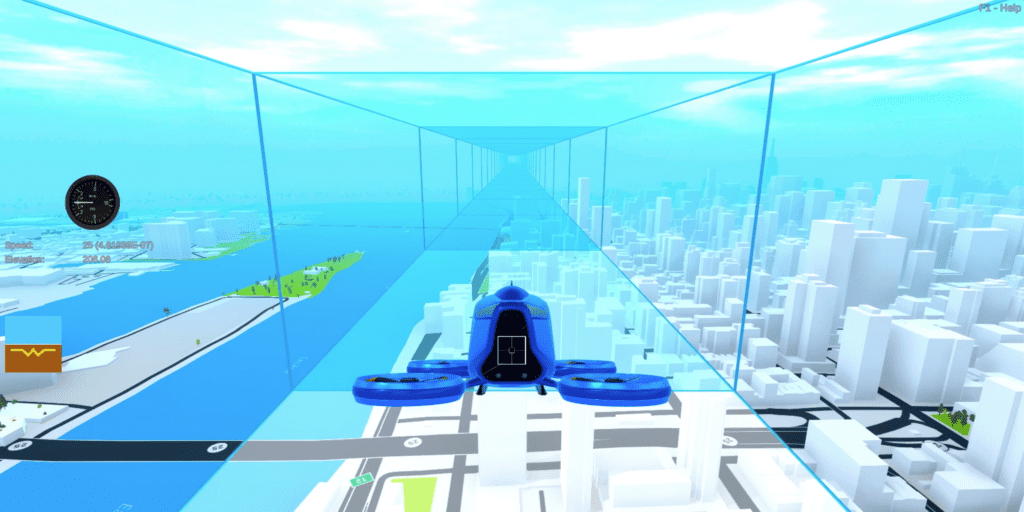
Using ground modules, avionics, transceivers, and sensor suites, the D3 Air Vehicle Control System (AVCS) will address route planning and execution while offering multiple layers of redundancy to assure safety. (D3 Technologies)
D3 Technologies wants to fill a gap in the Urban Air Mobility (UAM) space: air traffic management. Using ground modules, avionics, transceivers, and sensor suites, the D3 Air Vehicle Control System (AVCS) will address route planning and execution for electric vertical takeoff and landing (eVTOL) aircraft while offering multiple layers of redundancy to assure safety.
“We are basically saying, in order to be ready for the human part of urban air transport, a completely new paradigm in air traffic management needs to be developed and basically, that is what D3 is about,” Corvin Huber, CEO and CTO of D3 Technologies told Aviation Today. “I’m developing a rule-based method for handling man-carrying urban traffic, suggesting a system architecture that follows the required rules, and making a suggestion for means of compliance.”
The D3 AVCS will start flight testing in the middle of next year, Huber said. The goal of the flight test is to prove the system can communicate reliably with air vehicles. D3 is working with partners in the aerospace industry who are supplying communications technology.
“By the middle of next year we want to be flight testing a ground station, a communication backbone between vehicles and the ground and possibility between vehicles, and avionics components onboard the vehicles that create that kind of cohesive communication system and allows us to disseminate information from the ground station to air vehicles as to how they need to perform and behave in the sky,” Huber said.

The D3 AVCS will use deterministic planning to manage pilot routes and airspace traffic. (D3 Technologies)
The D3 AVCS will use deterministic planning to manage pilot routes and airspace traffic. This aspect of the technology will decrease travel time and increase safety, Huber said. Huber said some pilots or vehicle manufacturers might want to plan their own routes; however, D3 Technologies believe that in the long term this would be unsustainable.
“A vehicle operator will ask for a route between A and B or A and C and an automated system will determine what the best route for them to fly and that functionality is what we call deterministic planning because the planning will be such that it is accident-free out of the box,” Huber said. “It is not something that we would have to check or re-check as we would have to do if the route were suggested by the operator.”
However, D3 AVCS will provide flexibility within their routes offering pilots multiple options when available and could work within something similar to the corridors which the Federal Aviation Administration (FAA) in the U.S. has offered, Ralph Schuppenhauer, head of air traffic control at D3 Technologies, said.
“We think that if we look 10-15 years into the future, there’ll be so much traffic over large metropolitan areas that a quick fix like corridors, as they are defined today, won’t be enough,” Schuppenhauer said. “You will need a highly automated traffic management system that will allow air vehicles of the future to share rather small and crowded airspace and with completely new safety technologies that go far beyond see-and-avoid and that go far beyond what a human pilot is able to do.”

D3 AVCS will provide flexibility within their routes offering pilots multiple options when available and could work within something similar to the corridors which the Federal Aviation Administration (FAA) in the U.S. has offered. (D3 Technologies)
The D3 AVCS will use ground-to-air, air-to-ground, and air-to-air communication. The air-to-air communication will use an Internet of Things (IoT) element allowing vehicles to exchange communication themselves, Huber said.
The system would also use technology like machine learning (ML) and artificial intelligence (AI) in its traffic planning. Huber said the AI would have to be actively monitored to guarantee safety-critical standards.
“We believe that there is room here for machine learning and artificial intelligence, but the results of anything that derives from artificial intelligence will always have to be actively monitored, that is, run through a deterministic filter to make sure that at the end of the day, it remains conforming to the applicable safety standard,” Huber said.
D3 is looking to use Light Detection and Ranging (LiDAR) technology in its system during early testing. According to D3, Automatic Dependent Surveillance Broadcast (ADS-B) Out could initially be used to help with the identification of vehicles, however, additional sensors-types will be required for UAM.
Huber said the technology D3 Technologies is developing could also be used for traditional air traffic control operations. Helicopters or package-carrying drones could be equipped with their avionics and feed data back into the system.
“Eventually the avionics component of our system would be at a complexity level and a price point that you could also equip aircraft, which regularly occupy that urban airspace, with the equipment,” Huber said. “We believe that in initial phases we could use ADS-B data from existing air vehicles to create separation between vehicles participating in our system and other general aviation aircraft in the vicinity.”
D3 Technologies will be installing this system in Germany in 2022.
“We would like to be able to roll out this solution to flight test areas, not to urban applications but to fly test areas, by 2022,” Huber said. “So, we believe that we can equip areas who are interested in becoming model regionals for Urban Air Mobility with a first version of this communication and management tool in the course of 2022, and we’re actually planning to install this physically in a flight test area in the Munich region and another area in Germany and then offer the same system to areas worldwide.”